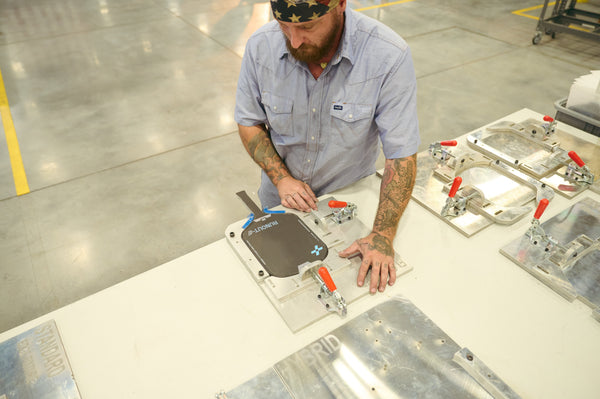The Science Behind F+B Carbon Fiber Pickleball Paddles: Power, Spin, and Control Explained
Advanced Materials with Purpose
F+B pickleball paddles are engineered with a construction philosophy rooted in aerospace: use the right materials in the right places. The face is built from Toray T700 raw carbon fiber, a material trusted for its stiffness and ability to grip the ball for maximum spin. Surrounding this face is our patented FUSIONFIBER frame and handle. FUSIONFIBER provides precision shaping, strategic mass placement, and durability that conventional composites cannot match. By concentrating more material at the corners and less at the lateral edges, stability and sweet spot expansion are achieved without adding unnecessary weight.
The core is U.S.-sourced polypropylene honeycomb, chosen for reliability and consistency, with an EVA foam ring inside to dampen vibration and further extend the sweet spot. Together, these materials deliver a paddle that feels powerful, yet balanced and forgiving.
Power With Control
At 12.7 mm thickness, these paddles lean toward the power category. The carbon fiber face transfers energy cleanly into the ball, allowing for big baseline drives and confident finishing shots. Unlike many power paddles that feel “hot” in the middle but dead at the edges, the FUSIONFIBER frame and EVA foam eliminate dead zones, keeping bounce consistent across the face. That consistency gives players the ability to apply power without sacrificing accuracy.
Spin Potential
The raw carbon fiber surface grips the ball longer, generating the dwell time needed for advanced spin. Whether it’s topspin serves, slice returns, or tight dinks at the kitchen line, the face lets players shape shots with precision. This spin capability adds variety and makes it harder for opponents to settle into rallies.
Confidence in Every Swing
A paddle should provide confidence, not hesitation. F+B paddles offer a large, forgiving sweet spot that delivers the same response across nearly the entire face. The FUSIONFIBER handle adds crisp bevels for a clean, connected feel, while also minimizing vibration during long exchanges. Players get the combination of power, touch, and comfort required for high-level performance.
Frequently Asked Questions About Carbon Fiber Pickleball Paddles
1. What is a carbon fiber pickleball paddle?
A carbon fiber pickleball paddle is made with carbon fiber layers on the paddle face. Carbon fiber is a lightweight yet durable material that provides excellent control, spin, and responsiveness compared to traditional fiberglass or wood paddles.
2. Are carbon fiber paddles better than fiberglass paddles?
It depends on your playing style. Carbon fiber paddles generally offer more control, touch, and precision, while fiberglass paddles provide extra pop and power. Many intermediate and advanced players prefer carbon fiber for its consistency and ability to generate spin.
3. Do carbon fiber pickleball paddles last longer?
Yes, carbon fiber is extremely durable and resistant to wear. A high-quality carbon fiber paddle can last longer than wood or fiberglass options, especially if properly cared for and not exposed to extreme heat or moisture.
4. Are carbon fiber paddles good for beginners?
They can be! Beginners who want to invest in a paddle with better control may benefit from carbon fiber. However, because they are often more expensive, some new players start with a composite or fiberglass paddle before upgrading.
5. How much does a carbon fiber pickleball paddle cost?
Prices typically range from $80 to $250, depending on the brand, technology, and weight. Premium paddles with advanced cores or edge-guard technology tend to be on the higher end.
6. Do carbon fiber paddles generate more spin?
Yes. Carbon fiber’s textured surface helps grip the ball, making it easier to add spin on serves, dinks, and volleys. This is one reason many competitive players choose carbon fiber models.
7. What is the difference between carbon fiber and graphite paddles?
The terms are sometimes used interchangeably, but they’re slightly different. Graphite paddles typically use a thin graphite layer, while carbon fiber paddles use woven carbon fiber, which is stronger and can enhance touch and control.
8. How do I choose the right carbon fiber pickleball paddle?
Consider your skill level, play style, and preferences:
Core thickness – Thicker cores mean more control and softer feel; thinner cores equate to more pop and power.
Grip length – Choose 5.5"+ if you use two-handed backhands or drives; shorter grips work well if you only use one-handed shots.
Core type – Polymer cores are quieter and softer; Nomex cores are firmer and louder.
9. Can carbon fiber paddles crack or break?
Yes, like any paddle, they can crack from hard impacts, repeated edge hits, or misuse. That said, carbon fiber is one of the most durable paddle materials available today.
10. How do I maintain a carbon fiber pickleball paddle?
Wipe the surface with a damp cloth after play.
Avoid leaving it in hot cars or direct sunlight.
Store in a protective cover to prevent scratches and chips.

























